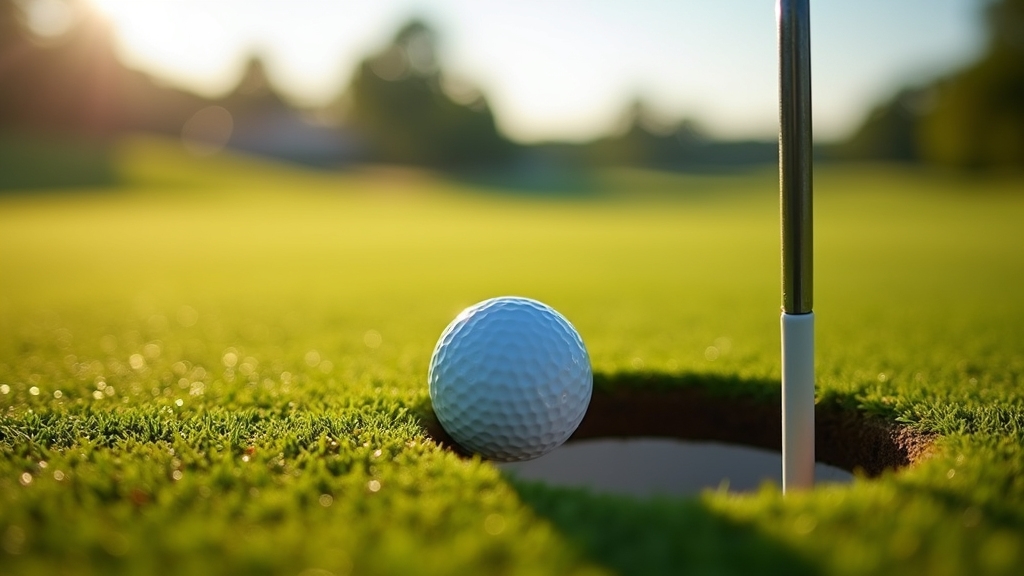A birdie in golf means you complete a hole one stroke under par, like scoring 3 on a par-4. It’s a key way to lower your score and shows skill. Making birdies boosts your confidence and gives you a competitive edge.
To get one, focus on precise shots, strong short game, and smart course management. Birdies also play a huge role in your overall performance and strategy.
Explore how to make more birdies and improve your game.
- Key Takeaways
- Definition and Basic Explanation of a Birdie
- History and Origin of the Term "Birdie"
- How to Achieve a Birdie on the Course?
- The Role of Birdies in Golf Scoring and Competition
- Comparison Between Birdie and Other Golf Scoring Terms
- Strategies to Increase Your Birdie Count
- Why Birdies Matter for Golfers of All Skill Levels?
- Frequently Asked Questions
- How Do Professional Golfers Celebrate After Scoring a Birdie?
- Are Birdies Tracked Differently in Match Play Versus Stroke Play?
- Can Weather Conditions Affect the Likelihood of Scoring Birdies?
- What Equipment Changes Can Help Improve Birdie Scoring Chances?
- How Do Golf Commentators Describe Birdies During Broadcasts?
- Turn Good Shots Into Great Ones With Smarter Technique
Key Takeaways
- A birdie in golf means completing a hole one stroke under its par score.
- The term originated in 1903 from American slang meaning “excellent” or “great shot.”
- Birdies improve scoring by lowering the total strokes taken during a round.
- Achieving a birdie requires precise shots, reaching the green in regulation, and strong putting skills.
- Birdies are crucial for competition, confidence, and measuring skill progress in golf.
Definition and Basic Explanation of a Birdie

A birdie happens when you complete a hole in one stroke under par. For instance, scoring a 3 on a par-4 or a 2 on a par-3 counts as a birdie. Par represents the expected number of strokes based on the hole’s length and difficulty, so a birdie shows you’ve beaten that standard by one.
Achieving a birdie marks skill and efficiency on the course. It’s not just about bragging rights; birdies play a vital role in lowering your total score, especially in competitive stroke play. The par for each hole is set by the USGA considering factors like hole length and difficulty. Using your handicap can help you understand how your birdies impact your net score in competitive settings.
Knowing how to spot and aim for birdies can help you improve your game and gain an edge in tournaments. Keep aiming for that one-under-par score!
History and Origin of the Term “Birdie”
Scoring a birdie is more than just an impressive feat on the golf course. It carries a rich history that dates back over a century, much like the importance of proper golf grip sizing in mastering the game.
Achieving a birdie is not just skillful—it’s a tradition steeped in over a hundred years of golf history.
The term “birdie” was born around 1903 at Atlantic City Country Club in New Jersey when golfer Abner Smith called a great shot a “bird of a shot,” using American slang for something excellent. A plaque at the club commemorates this origin of the term, marking its significance in golf history.
This phrase evolved to mean scoring one stroke under par on a hole. Unlike the British-origin “bogey,” “birdie” reflects a uniquely American contribution to golf language, capturing the spirit of skill and success. Today, understanding this origin adds depth to your appreciation of the game. It connects you to a tradition that celebrates remarkable shots and memorable achievements.
How to Achieve a Birdie on the Course?
To score a birdie, you really need to have a solid game plan in mind. It’s all about reaching the green in regulation, which means getting there in the fewest strokes possible. This way, you’re setting yourself up for a putt that you can handle. Wearing one golf glove can help improve your grip and control during those crucial shots.
And hey, it’s not just about the long shots; sharpening your short game is key! Focusing on your chipping and putting techniques will definitely give you an advantage when those birdie opportunities arise. Most birdies come from hitting the green in regulation and making a one-putt.
Shot Planning Strategies
Although executing a birdie requires skill, careful shot planning plays a crucial role in turning opportunities into success on the course. Visualize multiple scenarios before each shot, anticipating hazards like bunkers or water that can derail your progress.
Choose targets that maximize your margin for error, even if it means aiming away from the pin to avoid trouble. Play to your strengths by shaping shots, controlled draws or fades, to navigate the course layout and weather conditions effectively.
Mapping hazards and selecting safe aiming points reduce penalties and promote proper alignment for better shot accuracy. Adjust tee position to enhance shot shape and fairway access, as shot shaping can improve accuracy and safety. Prioritize approach shots that offer easy recovery options near the green.
Short Game Techniques
When you master short game techniques, you open essential opportunities to turn pars into birdies. Focus on consistent putting by controlling speed and alignment to avoid three-putts.
Practice drills like the clock and gate drills to sharpen your distance control and accuracy. For chipping, use varied swing lengths and select clubs based on shot trajectory—lower loft for bump-and-run, higher loft for soft landings. Properly organizing your practice routine will help maintain muscle balance and prevent fatigue.
Try the side-saddle method to reduce yips and improve contact confidence. Incorporate shot variations—low bump-and-run, medium chips, and high flops—to adapt to green conditions. Build a practice routine emphasizing target visualization, distance control, and pre-shot consistency.
Since over 60% of shots occur within 100 yards of the green, focusing on your short game can quickly elevate your overall golf performance. By refining these skills, you’ll confidently convert close-range chances into birdies, elevating your overall course performance.
The Role of Birdies in Golf Scoring and Competition
Since birdies directly lower your score on individual holes, they play a crucial role in golf scoring and competition. Understanding how birdies interact with the stroke index can help players optimize their scoring strategy.
Achieving birdies not only boosts your round score but also gives you a psychological edge, especially in match play. As you aim for birdies, you push yourself to improve approach shots, putting, and overall consistency, all critical for competitive success.
Imagine how birdies impact your game:
- Gaining valuable points in team formats and Stableford competitions.
- Building a scoring cushion to handle tough holes confidently.
- Tracking progress through birdie frequency to refine skills.
Professional golfers average 3-4 birdies per round, showing how birdies are both notable and achievable milestones.
Comparison Between Birdie and Other Golf Scoring Terms
You’ve probably heard that a birdie means finishing a hole one stroke under par, right? That’s a great achievement because it puts you ahead of the expected score. Understanding the difference between irons and wedges can help you execute the shots needed to reach birdie opportunities.
But did you know there are even rarer accomplishments in golf? For instance, an eagle means scoring two strokes under par, and then there’s the elusive albatross, which is three strokes under par. A condor, which is four strokes under par, is an incredibly rare feat with only four recorded in PGA history making it extremely rare.
Birdie Versus Par
Although par serves as the standard benchmark for each golf hole, scoring a birdie means you’ve completed the hole one stroke under that expected number. The precision and timing involved in achieving a birdie can be influenced by factors such as club weight and swing balance, which affect shot control and consistency.
Par represents the expected strokes for an expert golfer, while a birdie shows you’ve outperformed that standard. Achieving birdie requires skill and often involves riskier shots or precise putting, making it more challenging than par.
Consider these differences:
- Par feels like steady, reliable play, maintaining the course’s expected score.
- Birdie requires exceptional execution, reducing strokes below the norm.
Birdie attempts often increase pressure, demanding focus and confidence. Tour players make approximately two percentage points fewer birdie putts than par putts, largely because of the negativity bias that makes birdie putts feel more psychologically challenging.
Birdie, Eagle, Albatross
How do birdie, eagle, and albatross differ in golf scoring? A birdie means you finish a hole one stroke under par, like making three on a par-4. It’s a solid achievement and common among skilled players, who often select equipment like soft golf balls to enhance control and feel.
An eagle is tougher; you score two strokes under par, such as three on a par-5, giving you a bigger boost in your total score. The albatross, or double eagle, is the rarest and most impressive, scoring three under par, like completing a par-5 in two strokes.
Platforms like Golf Stat Lab provide tools to track these scoring achievements and analyze performance through detailed statistics, helping players improve their game. Golf tracking and improvement While birdies happen regularly for pros, eagles and albatrosses require exceptional skill and luck.
Each represents a higher level of under-par play, helping you lower your score and gain a competitive edge in tournaments.
Strategies to Increase Your Birdie Count
When aiming to boost your birdie count, focusing on precision and strategy from the tee to the green is essential. Selecting the right golf grip size can enhance your swing consistency and control. Start by hitting accurate drives that position you well for approach shots, avoiding hazards and tough lies.
Next, hone your iron and short game skills to land the ball within 10 feet of the hole, setting up makeable birdie putts. Data shows that hitting more greens in regulation significantly increases birdie opportunities. Finally, sharpen your putting, especially inside 5 feet, to confidently convert those chances.
Visualize a drive landing safely on the fairway, setting up an ideal angle to the green. icture your approach shot softly landing near the pin, giving you a straightforward birdie putt. Imagine sinking a calm, precise putt from just a few feet to celebrate a birdie.
Why Birdies Matter for Golfers of All Skill Levels?
Mastering strategies to increase your birdie count sets the stage for understanding why birdies hold significant value for golfers at every skill level. Birdies lower your overall score, directly impacting performance and leaderboard position. Professionals average 3.65 to 5 birdies per round, while amateurs see birdies as clear signs of improvement and skill mastery.
Birdies significantly reduce scores, boosting performance and confidence for both pros and amateurs alike.
Tracking your birdie or better percentage helps you assess scoring efficiency and pinpoint strengths or weaknesses in approach shots and putting. Birdies also boost your confidence, motivating precise play and smarter risk-taking.
Whether you’re a high-handicap player reducing bogeys or a scratch golfer refining your game, consistent birdies create a positive mental framework and measurable progress. This ultimately helps you perform better and enjoy golf more.
Frequently Asked Questions
How Do Professional Golfers Celebrate After Scoring a Birdie?
When you score a birdie, you often celebrate with a fist pump, raised arms, or a quick jump to express your excitement. Many pros share the moment with their caddies or acknowledge the crowd, showing genuine joy without disrupting play.
Keep your celebration brief and respectful, balancing your happiness with focus. This not only boosts your confidence but also earns respect from fellow players and fans, enhancing your game’s spirit.
Are Birdies Tracked Differently in Match Play Versus Stroke Play?
Think of birdies as chess moves: in match play, they’re your winning strikes on individual holes, not added points to a total score. You track birdies by who takes each hole, not cumulative strokes. In stroke play, every birdie chips away at your overall score, climbing the leaderboard.
Can Weather Conditions Affect the Likelihood of Scoring Birdies?
Yes, weather conditions definitely affect your chance of scoring birdies. Strong winds make your shots less predictable, reducing birdie opportunities. Rain softens greens, which can help approach shots stop quicker but slows putting, making birdies trickier.
Cold limits ball distance, while warm, moderate weather boosts your chances. Dry, firm courses can aid birdies by increasing roll, but extremes in weather often force you to play more cautiously, lowering birdie frequency.
What Equipment Changes Can Help Improve Birdie Scoring Chances?
You can improve your birdie chances by using modern clubs with lightweight graphite shafts for faster swing speeds and better control. Adjustable drivers let you fine-tune loft and weight for ideal launch.
Multi-layer balls provide distance and spin control, enhancing approach shots. For putting, try mallet putters with perimeter weighting and alignment aids to boost accuracy. These equipment upgrades help you get closer to the hole and convert more birdies confidently.
How Do Golf Commentators Describe Birdies During Broadcasts?
Golf commentators describe birdies with enthusiasm and vivid language, making you feel the excitement. They break down the shot’s difficulty, analyzing lies, distances, and green conditions, so you understand the skill involved.
Often, they build anticipation by predicting shot options before the attempt. You’ll hear a mix of technical insights and emotional reactions that highlight how pivotal the birdie is for the player’s momentum and tournament standing.
Turn Good Shots Into Great Ones With Smarter Technique
Now that you know what a birdie is, imagine this: professional golfers average about four birdies per round. That’s a clear sign of skill and precision you can aim for. By focusing on your technique and course strategy, you can start turning good shots into great ones.
Remember, every birdie brings you closer to lowering your score and enjoying the game even more. Keep practicing, and those birdies will soon become part of your regular play.

